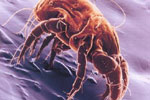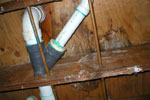  |
 Indoor Environmental Asthma Triggers The information provided here is courtesy of the Environmental Protection Agency (EPA). Secondhand Smoke
Secondhand Smoke
Secondhand smoke, also known as Environmental Tobacco Smoke (ETS), consists of exhaled smoke from smokers and side stream smoke from the burning end of a cigarette, cigar or pipe. Secondhand smoke contains more than 4,000 substances, including over 40 compounds that are known carcinogens. How Does Secondhand Smoke Affect Asthma? Secondhand smoke can trigger asthma episodes and increase the severity of attacks. Secondhand smoke is also a risk factor for new cases of asthma in preschool aged children who have not already exhibited asthma symptoms. Scientists believe that secondhand smoke irritates the chronically inflamed bronchial passages of people with asthma. Secondhand smoke is linked to other health problems, including lung cancer, ear infections and other chronic respiratory illnesses, such as bronchitis and pneumonia. |
|
Many of the health effects of secondhand smoke, including asthma, are most clearly seen in children because children are most vulnerable to its effects. Most likely, children's developing bodies make them more susceptible to secondhand smoke's effects and, due to their small size, they breathe more rapidly than adults thereby taking in more secondhand smoke. Children receiving high doses of secondhand smoke, such as those with smoking mothers, run the greatest relative risk of experiencing damaging health effects. Actions You Can Take
Dust mites are tiny insects that are invisible to the naked eye. Every home has dust mites. They feed on human skin flakes and are found in mattresses, pillows, carpets, upholstered furniture, bedcovers, clothes, stuffed toys and fabric and fabric-covered items. Body parts and feces from dust mites can trigger asthma in individuals with allergic reactions to dust mites, and exposure to dust mites can cause asthma in children who have not previously exhibited asthma symptoms. Actions You Can Take
Common house dust may contain asthma triggers. When you are treating your house for dust mites, try these simple steps as well.
Molds are microscopic fungi that live on plant and animal matter. Molds can be found almost anywhere; they grow on virtually any substance when moisture is present. Molds produce tiny spores to reproduce, just as plants produce seeds. Mold spores waft through the indoor and outdoor air continually. When mold spores land on a damp spot indoors, they may begin growing and digesting whatever they are growing on in order to survive. Some molds can grow on wood, paper, carpet, foods and even dynamite. There is no practical way to eliminate all molds indoors; the way to control indoor mold growth is to control moisture. If you think you have a mold problem and can see mold growth, you do not need environmental testing to determine what kind of mold you have. Instead, simply clean the mold from the surface it's growing on and dry the surface thoroughly. For people sensitive to molds, inhaling mold spores can cause an asthma attack. Actions You Can Take
Droppings or body parts of cockroaches and other pests can trigger asthma. Certain proteins, called allergens, are found in cockroach feces and saliva and can cause allergic reactions, or trigger asthma symptoms, in some individuals. Cockroaches are commonly found in crowded cities and the southern regions of the United States. Cockroach allergens likely play a significant role in asthma in many inner-city areas. Actions You Can Take An important key to pest management is to remove places in your home for pests to hide and to keep exposed areas free of food and water. But remember, pesticides you may spray to prevent pests are not only toxic to pests, they can harm people too. Try to use pest management methods that pose less of a risk. Tips to prevent pests:
If sprays are used:
NATIONAL PESTICIDES TELECOMMUNICATIONS NETWORK
Your pet's dead skin flakes, urine, feces, saliva and hair can trigger asthma. Dogs, cats, rodents (including hamsters and guinea pigs) and other mammals can trigger asthma in individuals with an allergic reaction to animal dander. Proteins in the dander, urine or saliva of warm-blooded animals (e.g., cats, dogs, mice, rats, gerbils, birds, etc.) have been reported to sensitize individuals and cause allergic reactions or trigger asthma episodes in individuals sensitive to animal allergens. The most effective method to control animal allergens in the home is to not allow animals in the home. If you remove an animal from the home, it is important to clean the home (including floors and walls, but especially carpets and upholstered furniture) thoroughly. Pet allergen levels are reported to stay in the home for several months after the pet is removed even with cleaning. Isolation methods to reduce animal allergen in the home have also been suggested by reputable health authorities (e.g., keeping the animal in only one area of the home, keeping the animal outside or ensuring that people with allergies or asthma stay away from the animal) but the effectiveness of these methods has not been determined. Several reports in the literature indicate that animal allergen is carried in the air and by residents of the home on their clothing to all parts of the home, even when the animal is isolated. In fact, animal allergen is often detected in locations where no animals were housed. Often, people sensitive to animal allergens are advised to wash their pets regularly. Recent research indicates that washing pets may only provide temporary reductions in allergen levels. There is no evidence that this short term reduction is effective in reducing symptoms and it has been suggested that during the washing of the animal the sensitive individual may be initially exposed to higher levels of allergens. Thus, the most effective method to control exposure to animal allergens is to keep your home pet free. However, some individuals may find isolation measures to be sufficiently effective. Isolation measures that have been suggested include keeping pets out of the sleeping areas, keeping pets away from upholstered furniture, carpets, and stuffed toys, keeping the pet outdoors as much as possible and isolating sensitive individuals from the pet as much as possible. Actions You Can Take
Nitrogen Dioxide (NO2) can be a byproduct of fuel-burning appliances, such as gas stoves, gas or oil furnaces, fireplaces, wood stoves and unvented kerosene or gas space heaters. NO2 is an odorless gas that can irritate your eyes, nose and throat and cause shortness of breath. In people with asthma, exposure to low levels of NO2 may cause increased bronchial reactivity and make young children more susceptible to respiratory infections. Long-term exposure to high levels of NO2 can lead to chronic bronchitis. Actions You Can Take
Copyright © 2004-2020 - Scott Sauer - All Rights Reserved E-mail Web Master at asiinspector@gmail.com |




